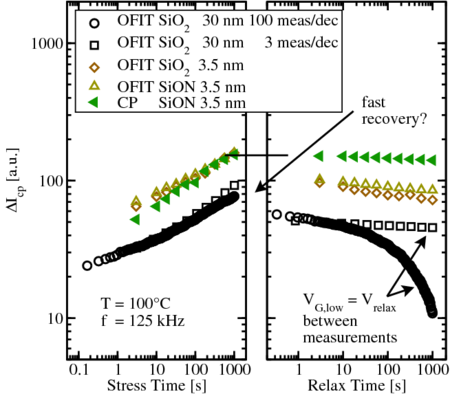5.4 OFIT versus CP
As in conventional CP measurements, care has to be taken that parasitic
tunneling currents and geometry effects do not pollute the measured charge
pumping current  . The first problem is even more severe in the OFIT
technique since there the low level gate voltage equals the stress voltage,
resulting in excessive tunneling in thin oxides [51]. In order to avoid these
problems, also large-area devices with thick oxides (
. The first problem is even more severe in the OFIT
technique since there the low level gate voltage equals the stress voltage,
resulting in excessive tunneling in thin oxides [51]. In order to avoid these
problems, also large-area devices with thick oxides ( ) are used. As shown
in Fig. 5.12, the measured
) are used. As shown
in Fig. 5.12, the measured  during stress and recovery are qualitatively
identical for three completely different technologies (
during stress and recovery are qualitatively
identical for three completely different technologies ( thick
thick  ,
,  thin
thin  , and
, and  ).
).
Quite remarkably, continuous application of OFIT pulses (as well as
CP measurements) has a dramatic impact on both the stress and the
recovery characteristics. In particular, with 3 measurements per decade of
relaxation time,  is quasi constant during recovery, while up to 100
measurements per decade in time result in approximately 80% recovery of
is quasi constant during recovery, while up to 100
measurements per decade in time result in approximately 80% recovery of
 .
.
Another fact is that the first OFIT measurement point during stress is
already responsible for at least 30% of the total degradation. Likewise, the first
measurement taken during recovery at  already shows
already shows  recovery
while the rest of the recovery depends basically on the number of measurements
per decade. Though not shown here, the same behavior is obtained for CP. To be
able to understand how recovery works here, a deeper analysis of the charge
pumping technique is needed.
recovery
while the rest of the recovery depends basically on the number of measurements
per decade. Though not shown here, the same behavior is obtained for CP. To be
able to understand how recovery works here, a deeper analysis of the charge
pumping technique is needed.
 . The first problem is even more severe in the OFIT
technique since there the low level gate voltage equals the stress voltage,
resulting in excessive tunneling in thin oxides [51]. In order to avoid these
problems, also large-area devices with thick oxides (
. The first problem is even more severe in the OFIT
technique since there the low level gate voltage equals the stress voltage,
resulting in excessive tunneling in thin oxides [51]. In order to avoid these
problems, also large-area devices with thick oxides ( ) are used. As shown
in Fig. 5.12, the measured
) are used. As shown
in Fig. 5.12, the measured  during stress and recovery are qualitatively
identical for three completely different technologies (
during stress and recovery are qualitatively
identical for three completely different technologies ( thick
thick  ,
,  thin
thin  , and
, and  ).
).

 ).
Furthermore, continuous gate pulsing affects both stress and relaxation,
causing a faster recovery of interface states with increasing number of
measurements (black circles vs. black squares, both of
).
Furthermore, continuous gate pulsing affects both stress and relaxation,
causing a faster recovery of interface states with increasing number of
measurements (black circles vs. black squares, both of  OFIT).
OFIT).  is quasi constant during recovery, while up to 100
measurements per decade in time result in approximately 80% recovery of
is quasi constant during recovery, while up to 100
measurements per decade in time result in approximately 80% recovery of
 .
.
 already shows
already shows  recovery
while the rest of the recovery depends basically on the number of measurements
per decade. Though not shown here, the same behavior is obtained for CP. To be
able to understand how recovery works here, a deeper analysis of the charge
pumping technique is needed.
recovery
while the rest of the recovery depends basically on the number of measurements
per decade. Though not shown here, the same behavior is obtained for CP. To be
able to understand how recovery works here, a deeper analysis of the charge
pumping technique is needed.